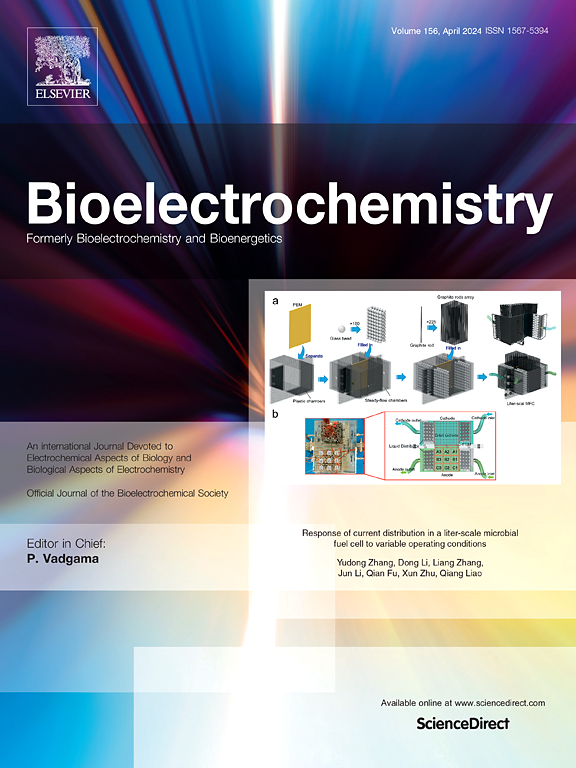A high-sensitivity ECL biosensor for single-cell analysis: Integrating CRISPR/Cas12a and entropy-driven amplification
IF 4.5
2区 化学
Q1 BIOCHEMISTRY & MOLECULAR BIOLOGY
引用次数: 0
Abstract
This study presents a homogeneous electrochemiluminescence (ECL) biosensor for ultrasensitive detection of HEK293 cells by targeting the hERG potassium channel at the single-cell level. The biosensor integrates multiple signal amplification steps, including photocleavable DNA–antibody conjugates, entropy-driven strand displacement, T7 RNA polymerase-mediated transcription, and CRISPR/Cas12a-mediated trans-cleavage. This cascade enables precise and robust signal enhancement. A key feature of the system is its ability to generate a clearly measurable ECL response from as little as a single HEK293 cell, without the need for signal averaging. Specificity was confirmed using unrelated cell lines and mismatched DNA sequences, with minimal background observed in negative controls. Optimization of key parameters—such as enzyme concentrations, reaction times, and duplex composition—ensured consistent and reproducible performance. ECL measurements were conducted under a defined voltage scan (0–1.3 V) in a three-electrode system, and emission signals were recorded using a photomultiplier tube. This biosensor demonstrates the feasibility of single-cell detection with high sensitivity and specificity, offering a promising platform for future applications in cell-based analysis and molecular diagnostics.
用于单细胞分析的高灵敏度ECL生物传感器:整合CRISPR/Cas12a和熵驱动扩增
本研究提出了一种均匀电化学发光(ECL)生物传感器,用于在单细胞水平上靶向hERG钾通道对HEK293细胞进行超灵敏检测。该生物传感器集成了多个信号放大步骤,包括光可切割的dna -抗体偶联物、熵驱动的链位移、T7 RNA聚合酶介导的转录和CRISPR/ cas12a介导的反式切割。这种级联可以实现精确和稳健的信号增强。该系统的一个关键特点是它能够从单个HEK293细胞中产生清晰可测量的ECL反应,而无需信号平均。特异性用不相关的细胞系和不匹配的DNA序列证实,阴性对照中观察到的背景最小。关键参数的优化,如酶浓度,反应时间和双相组成,确保了一致和可重复的性能。在三电极系统中,ECL测量在定义的电压扫描(0-1.3 V)下进行,并使用光电倍增管记录发射信号。该生物传感器证明了单细胞检测的可行性,具有高灵敏度和特异性,为未来在细胞分析和分子诊断中的应用提供了一个有希望的平台。
本文章由计算机程序翻译,如有差异,请以英文原文为准。
求助全文
约1分钟内获得全文
求助全文
来源期刊

Bioelectrochemistry
生物-电化学
CiteScore
9.10
自引率
6.00%
发文量
238
审稿时长
38 days
期刊介绍:
An International Journal Devoted to Electrochemical Aspects of Biology and Biological Aspects of Electrochemistry
Bioelectrochemistry is an international journal devoted to electrochemical principles in biology and biological aspects of electrochemistry. It publishes experimental and theoretical papers dealing with the electrochemical aspects of:
• Electrified interfaces (electric double layers, adsorption, electron transfer, protein electrochemistry, basic principles of biosensors, biosensor interfaces and bio-nanosensor design and construction.
• Electric and magnetic field effects (field-dependent processes, field interactions with molecules, intramolecular field effects, sensory systems for electric and magnetic fields, molecular and cellular mechanisms)
• Bioenergetics and signal transduction (energy conversion, photosynthetic and visual membranes)
• Biomembranes and model membranes (thermodynamics and mechanics, membrane transport, electroporation, fusion and insertion)
• Electrochemical applications in medicine and biotechnology (drug delivery and gene transfer to cells and tissues, iontophoresis, skin electroporation, injury and repair).
• Organization and use of arrays in-vitro and in-vivo, including as part of feedback control.
• Electrochemical interrogation of biofilms as generated by microorganisms and tissue reaction associated with medical implants.
 求助内容:
求助内容: 应助结果提醒方式:
应助结果提醒方式:


